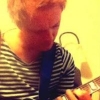You must have intended to put [GIMP] at the end of that sentence, because the Color to Clear in GIMP is quick, easy, and reliable. At first, I believed that I would rarely use this function but I find many ways to Color to Clear in manipulating an image.
Yes, that is correct. I don't know where the rest of my sentence went. Digital nirvana it seems.
I use it very often. For example I like to bake my AO maps into the Texture as most shaders will not have an AO slot, and frankly, baking it into the diffuse Map looks just right most of the time.
Here you can use the function to transform the white part of the AO map to clear, and then place this as a layer over your Diffuse map. you can play around with the opacity and stuff like that to get the intensity of the AO right, and there you go: AO added to the diffuse map with few simple clicks.
Of course you still need to bake out the AO map in a 3D Tool first....








